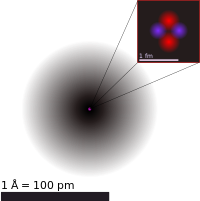
Photo from wikipedia
Herein, we report the synthesis of a bifunctional photocatalyst, Zr-OTf-EY, through sequential modifications of metal cluster nodes in a metal-organic layer (MOL). With eosin Y and strong Lewis acids on… Click to show full abstract
Herein, we report the synthesis of a bifunctional photocatalyst, Zr-OTf-EY, through sequential modifications of metal cluster nodes in a metal-organic layer (MOL). With eosin Y and strong Lewis acids on the nodes, Zr-OTf-EY catalyzes cross-coupling reactions between various C-H compounds and electron-deficient alkenes or azodicarboxylate to afford C-C and C-N coupling products, with turnover numbers of up to 1980. In Zr-OTf-EY-catalyzed reactions, Lewis acid sites bind the alkenes or azodicarboxylate to increase their local concentrations and electron deficiency for enhanced radical additions, while EY is stabilized by site isolation on the MOL to afford a long-lived catalyst for hydrogen atom transfer. The proximity between photostable EY sites and Lewis acids on the nodes of Zr-OTf-EY enhances the catalytic efficiency by approximately 400 times over the homogeneous counterpart in the cross-coupling reactions.
Journal Title: Journal of the American Chemical Society
Year Published: 2023
Link to full text (if available)
Share on Social Media: Sign Up to like & get
recommendations!